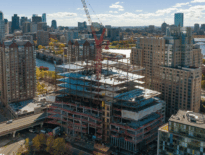Michael Nichols
President, Downtown Boston Business Improvement District
Age: 39
Industry experience: 14 years
As the new president of the Downtown Boston Business Improvement District, Michael Nichols finds himself in a familiar role managing civic spaces that rely on public-private partnerships to thrive. The executive director of the Esplanade Association for the past five years and a former chief of staff at the Rose Kennedy Greenway Conservancy, Nichols previously held roles in city and state government. Created in 2011, the Downtown Boston BID provides services and promotions in a 34-block area including Downtown Crossing and portions of the Financial and Theater districts, paid through assessments on commercial landlords. Nichols succeeds the late Rosemary Sansone, the BID director from its founding until her retirement in January.
Q: What are your impressions of the key recommendations of the administration’s downtown revitalization report?
A: They got a lot right. If there was just one recommendation and someone was trying to advocate for the way we can get people back in their offices, I would be skeptical. The winning path is to try to lean into tourism and regional visitors who live close to Boston, coming in to the theaters and shows and restaurants. We’re trying to feature more of a mixed-use neighborhood for downtown. I talked to a lot of different restaurant owners and they’ve told me that the tourists are back and they are spending. The students and tourists and the theater visitors are back as much, if not more, than before the pandemic, and the only diminished traffic at the moment is the office workers on Monday and Fridays. I like the [revitalization report] recommendation about trying to develop more promotions. In a visit to New Orleans recently, one week there was a jazz festival, the next one was seafood, and they had a drumbeat of things that branded why New Orleans is a place to be. I think we can do a better job of that.
Q: What’s the Downtown Boston BID’s role in this process?
A: The big one that we probably haven’t had to do much in our 12 years is economic development and business development. Rosemary Sansone did an amazing job of organizing and catalyzing a positive trajectory for us from 2010 to 2020 and the bounceback from the Great Recession. While we certainly had vacancies, that was less an issue. We need to be more proactive in attracting first-floor retail, and the BID can be a catalyst for the office space. There’s an opportunity for downtown Boston to be a counterpoint to some of the other regional commercial centers: the Seaport, Fenway, Back Bay. We have the diversity of the people coming in on all four of the MBTA lines. Downtown Boston does look like the rest of the city of Boston in one place.
Q: Does the licensing and permitting process need to be reformed to attract more retail?
A: The city is talking about trying to lessen some of those barriers, and the city announced a $9 million fund that’s going to start to help identify retail spaces and a stipend to get businesses up and running, and that might be a big difference for a number of the vacant storefronts in downtown Boston. Owners are willing to take a chance on a short- or medium-range business opportunity that’s more than pop-ups, to give them a running start that they arguably might not be able to afford before. Between that and the BID’s willingness to ramp up technical assistance for businesses, that should start to chip away at the growing retail vacancies. The last estimate is something like 20 percent in the downtown core.
Q: How can the Boston Planning & Development Agency’s resumption of the PLAN: Downtown study benefit the BID area?
A: Two areas I hear they are going to look at and make sense is softening or amending the definition of retail in the downtown area. The city allowing more childcare and daycare spaces in first-floor retail, which may not be allowed or are conditional uses, is a terrific idea. The other one is residences. Much has been made about conversions. Zoning can certainly play a factor in how attractive it is to develop housing downtown. For this to become a 16- or 24-hour neighborhood, we need significant residences at various affordability levels, whether through conversions or new development.
Q: How does your background at the Esplanade and Greenway Conservancy translate to your current duties?
A: I had the good fortune at the Greenway Conservancy and the Esplanade to manage dynamic public spaces, and those spaces sit at the intersection of economic development, programming, public art and tourism. I’m super motivated about downtown and its possibilities. It means something to the fabric of the city. The downtown has seen war and recession and Depression and now COVID, and it always bounced back as something that blends the old and the new.
Q: How can the BID combat concerns about public safety that may deter more visitor traffic?
A: It may sound a little trite, but they should visit. Most of the social challenges that exist in downtown Boston are true of every single major city in America. There has always been a component of social challenges to the urban fabric. We now have more restaurants and bars open in our district than before the pandemic. As the tourists fill the streets and office workers and shoppers, the social challenges don’t feel like they comprise as big a percentage of what’s happening on the streets. Most of the people who have that negative perception aren’t spending much time here, and I’m encouraging them to come in.
Q: What are some potential locations that have been discussed for new permanent street closings to improve pedestrianization?
A: The Summer Street pedestrian plaza is a total success. You have an area where people can sit around and we have a live band and ambassadors giving out our maps and brochures. That’s a tremendous civic experience. We think there can be expansion to the Summer Street pedestrian plaza, where you’re able to loop in another block or two and see if we can grow the area.
Nichols’ Favorite Downtown Pedestrian Plazas
- Downtown Crossing, Boston
- Latin Quarter, Galway, Ireland
- Plaza Vieja, Havana, Cuba
- Plaza de Armas, Cuzco, Peru
- Marienplatz, Munich, Germany






